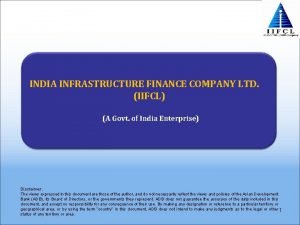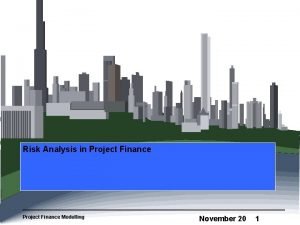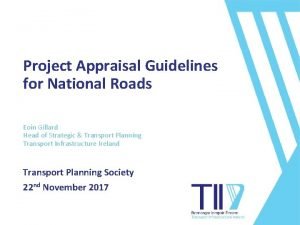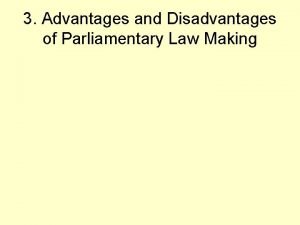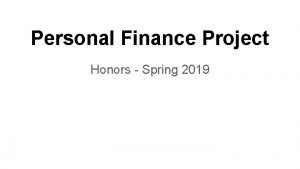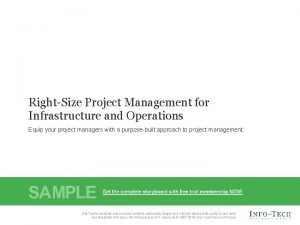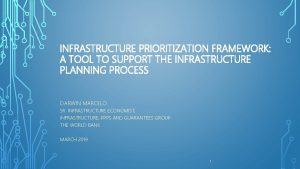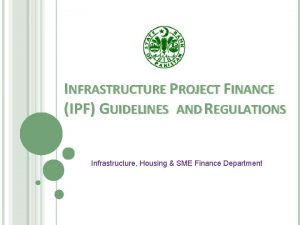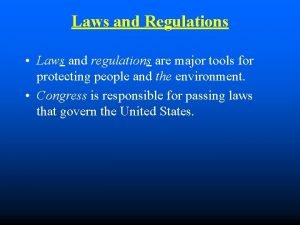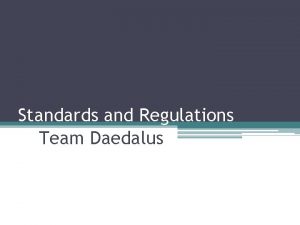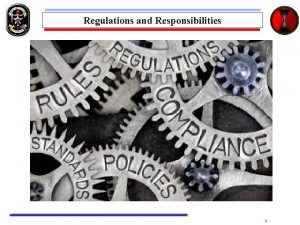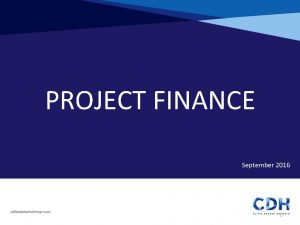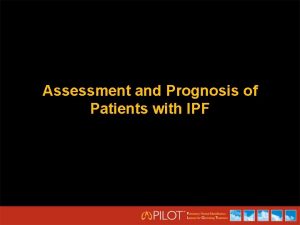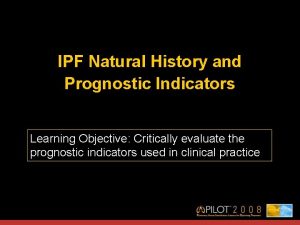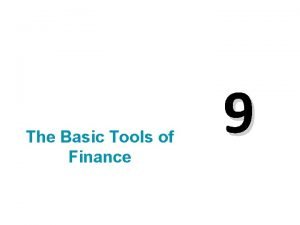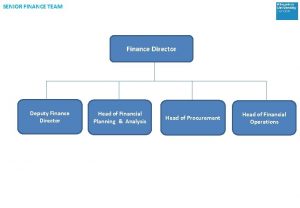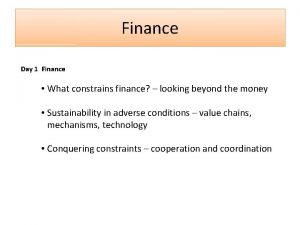INFRASTRUCTURE PROJECT FINANCE IPF GUIDELINES AND REGULATIONS Infrastructure

























- Slides: 25

INFRASTRUCTURE PROJECT FINANCE (IPF) GUIDELINES AND REGULATIONS Infrastructure, Housing & SME Finance Department

BENEFITS OF INFRASTRUCTURE DEVELOPMENT Development of Infrastructure enhances Public Assets Quality infrastructure improves the investment climate foreign direct investment (FDI) by reducing costs Enhances export competitiveness Creates employment Improves living conditions of public Higher tax revenue of government

IMPEDIMENTS TO INFRASTRUCTURE PROJECT FINANCING IN PAKISTAN Transaction amount in the infrastructure sector is sizable compared to the size of many banks/DFIs Project financing is not a high priority due to reluctance to undertake long term payback ventures There is a lack of specialized project finance expertise within commercial banks/DFIs Absence of long-term debt instruments/bond market

TREND IN IPF Based on data collected from Banks/DFIs on Infrastructure Project Financing, it has been observed that financing has decreased over the years

TOTAL AMOUNT OUTSTANDING UNDER INFRASTRUCTURE PROJECT FINANCING (YEARLY) 320 298, 5 Billion Rs 300 288, 6 280 275, 9 280, 7 255, 2 260 240 234, 4 220 200 Dec-08 Dec-09 Dec-10 Dec-11 Dec-12 Dec'13

TOTAL AMOUNT OUTSTANDING UNDER IPF (QUARTERLY) 295 288, 6 286, 3 Billion Rs 285 286, 2 281, 5 275 266, 2 273, 2 265 266, 9 254, 6 255, 2 245 Mar-12 Jun-12 Sep-12 Dec-12 Mar-13 Jun-13 Sep-13 Dec-13 Mar-14

INSTITUTION WISE SHARE IN IPF (OUTSTANDING) Foreign Islamic 1% 2% DFIs 5% Private Sector 73% Public Sector 20%

SECTOR WISE SHARE IN CUMULATIVE DISBURSEMENTS 2% 1%0% 3%0% Telecom 7% 13% 6% 4% Power Generation Power Transmission Petroleum LPG Extract. Dist. 63% LPG Import & Dist Oil & Gas Explor. Distr. Road, Bridge, Flyover Water Supply, Sanitation Any other

SBP INITIATIVES Issuance of Guidelines on Infrastructure Project Financing Capacity development programs for Banks/DFIs Establishment of Infrastructure Task Force Facilitation in establishment of Infrastructure Development Finance Institution (IDFI) – (Concept Paper Preparation) Consultation with various stakeholders through workshops, seminars and working groups. Quarterly Infrastructure Project Financing review.

INFRASTRUCTURE DEVELOPMENT AND FINANCING INSTITUTION (IDFI) Need � Asset / Liability mismatch in banks/DFIs as most of the deposits are of short tenor. � Lack of adequate funding for large infrastructure projects IDFI will perform a broad array of activities: • • • Project Development – need identification, conceptualization, pre-feasibility reports, commercial viability aspects, identification of potential investors Use of innovative structural / financial techniques to enhance project viability Evaluate infrastructure projects for potential investment Project Finance – equity participation, loan syndication, other services Facilitate access to Viability Gap Fund Tariff and other advisory services Facilitate co-ordination of project sponsors with relevant ministries and government departments Performance Monitoring May help government in PPP policy formulation

INFRASTRUCTURE DEVELOPMENT AND FINANCING INSTITUTION (IDFI) Primary focus will be on: � Power Sector � Special Economic Zones � Agricultural Infrastructure including warehousing, cold chains etc. Other sectors like road, railway and port etc. would also be considered later on subject to capacity enhancement Long term funding mechanism to develop a financial climate conducive to large scale infrastructure projects

IDFI Scope and Structure • Proposed IDFI to be established as a special DFI with suggested Equity Distribution as follows: - Banks/DFIs - 25% - Go. P or government organizations - 25% - Multilateral Agencies - 50% • The company will issue long term papers/Bonds/Sukuk to generate funds from local market and also seek funding and guarantee lines from international MLAs to support/finance infrastructure projects in Pakistan. By issuing bonds/Sukuk, it would help develop capital market.

SBP Guidelines/Regulatory Framework - History Relaxation in Prudential Regulations for Infrastructure Project Financing (IPF) vide BPD Circular No. 25 dated July 04, 2003 (http: //www. sbp. org. pk/bpd/2003/C 25. htm). � Debt equity relaxed to 80: 20 for the Infrastructure projects � “Concession Agreement/License/Right of Way” issued by Government accepted as a collateral Updated IPF Guidelines in August 31, 2010 vide No. IHFD/11 /191/ 2010. The salient features of the revised guidelines: Includes the requirement for establishing a mechanism for generating feasibility reports and assessing risk mitigation means in the development, construction, start-up and operation stages of the project. Banks and DFIs to establish a proper process for the continuous monitoring of project implementation to ensure proper utilization of the credit while relevant bank accounts will be subject to audit by the SBP. Banks and DFIs encouraged to accept Concession Agreement/Lisence issued by a government agency as collateral. The institutions to ensure adequate insurance coverage against all potential risks applicable to the project. At no point shall the bank’s exposure to the risk exceed the bank’s equity, and the exposure availed by any borrower shall also not exceed 10 times the borrower’s equity. 13

SBP Guidelines – Areas Covered Part-A: DEFINITIONS Part-B: GUIDELINES G. 1: Credit Appraisal G. 1. 1 : Minimum Information Requirements G. 1. 2 : Assessment of Infrastructure Projects G. 1. 3 : Monitoring of Infrastructure Projects G. 2: Collateral Arrangements, Security Package And Project Insurance G. 2. 1 : Acceptance of Concession/License as Collateral G. 2. 2 : Security Package G. 2. 3 : Project Insurance G. 3: Regulatory Compliance G. 3. 1 : Exposure Limit G. 3. 2 : Debt-Equity G. 3. 3 : Funding of Infrastructure Projects G. 3. 4 : Provisioning Requirements Part-C : Annexes Annex A - IPF: Checklist for Minimum Information Requirements Annex B - IPF: Provisioning Requirements 14

SBP Guidelines- What is an Infrastructure? Infrastructure Project means one of the followings: a) A road, including toll road, fly over, bridge project. b) A mass transit, urban bus, urban rail project. c) A rail-bed, stations system, rail freight, passenger services project. d) A telecommunication local services, long distance and value added project. e) A power generation project. f) A power transmission or distribution project by laying a network of new transmission or distribution lines. g) A natural gas exploration and distribution project. h) An LPG extraction, distribution and marketing project. i) An LPG import terminal, distribution and marketing project. j) An LNG (Liquefied Natural Gas) terminal, distribution and marketing project. k) A water supply, irrigation, water treatment system, sanitation and sewerage system or solid waste management system project. l) A dam, barrage, canal project. m) A primary and secondary irrigation, tertiary (on-farm) irrigation project. n) A port, channel dredging, shipping, inland waterway, container terminals project. o) An airport. 15 p) A petroleum extraction, refinery, pipeline project. q) Any other infrastructure project of similar nature, notified by SBP.

SBP Guidelines- Credit Appraisal G. 1 – CREDIT APPRAISAL q G. 1. 1: Minimum Information Requirements i. Project Description ii. Capital Investment iii. Project Schedules iv. Environmental Impact v. Financing vi. Legal Documentation 16

SBP Guidelines –G. 1 (contd. . . ) q G 1. 2 : Assessment of Infrastructure Projects – Development Phase – should be preferably funded through equity – Construction & Start-up Phase – Assessment of physical and financial completion of infrastructure projects. Some important tools used for completion risk mitigation are: § Project Funds Agreement § Financial Completion Agreement § Insurance [Ongoing construction period monitoring through: i. Technical advisor, via milestone certifications and site visits 17

SBP Guidelines –G. 1 (contd. . . ) Keeping the financial model live during the construction period; and iii. Monitoring of project accounts for disbursements and payments of project expenses] – Operation Phase – Entails monitoring of: i. Assignment of project receivables and damages ii. Continuous presence of valid security arrangement iii. Debt repayment and project’s escrow accounts iv. Financial covenants for debt repayment v. Technical monitoring during operations and construction phases ii. 18

SBP Guidelines –G. 1 (contd. . . ) q G. 1. 3 : Monitoring of Infrastructure Projects Monitoring for assignment of Project Receivables and Payments for Damages. Monitoring for ensuring enforcement of Security Projects escrow accounts for Monitoring of Repayment of Debt. Financial Covenants for Repayment of Debt. Technical Monitoring during Development and Operation Phase. 19

SBP Guidelines- G. 2 – COLLATERAL ARRANGEMENT, SECURITY PACKAGE &PROJECT INSURANCE q G. 2. 1: Acceptance of Concession/license as collateral – encumbrance free, assignable, transferable in the event of default q G. 2. 2: Security Package – – Primary Security – first charge over project receivables and accounts – Secondary Security – standard security package of the lenders including hypothecation, mortgage, insurance assignment, share pledge, assignment over rights under all project documents etc q G. 2. 3: Project Insurances - construction all risks, third party liability, marine, accidental, loss of profit, terrorism insurance etc. 20

SBP Guidelines- G. 3 – REGULATORY COMPLIANCE q G. 3. 1: Exposure Limit – per party exposure (as per regulation R-1 of Corporate Banking PRs), total bank exposure to project finance assets (not to exceed the bank’s equity) fund and non-fund based exposures q G. 3. 3: Funding of Infrastructure Projects – – Loan duration – up to 20 years (excluding grace period) – Asset Liability Management – interest rate and liquidity risk management – Arrangement of Long-term Funding – churning more IPF assets using securitization q G. 3. 4: Classification and Provisioning Requirements – Annex IV of R 8 21

PR R-1: Limit on Exposure to a Single Person/Group 5. For the purpose of this regulation banks/DFIs are required to follow the guidelines given at Annexure-I. Effective Date For Single Person For Group Total O/S (Fund & Non Fund Based) exposure limit Fund based O/S Limit 31 -12 -2009 30 20 45 35 31 -12 -2010 30 20 40 35 31 -12 -2011 30 20 35 30 31 -12 -2012 30 20 30 25 31 -12 -2013 25 25 22

PR: R-8 Annex IV (Classification & Provisioning) Classification Determinant Treatment of Income Provisions to be Made Substand ard Where markup/ interest or principal is overdue by 90 days or more from the due date. Unrealized mark-up /interest to be kept in Memorandum Account and not to be credited to Income Account except when realized in cash. Unrealized mark up/interest already taken to income account to be reversed and kept in Memorandum Account. Provision of 25% of the difference resulting from the outstanding balance of principal less the amount of liquid assets realizable without recourse to a Court of Law and 40% of the Forced Sale Value (FSV) of pledged stocks and mortgaged residential, commercial and industrial properties (see Note 2 below). Doubtful Where markup/ interest or principal is overdue by 180 days or more from the due date. As above Provision of 50% of the difference resulting from the outstanding balance of principal less the amount of liquid assets realizable without recourse to a Court of Law and 40% of the Forced Sale Value (FSV) of pledged stocks and mortgaged residential, commercial and industrial properties (see Note 2 below). Loss a) Where markup/ interest or principal is overdue by one year or more from the due date As above b) Where Trade Bills (Import/Export or Inland Bills) are not paid/adjusted within 180 days of the due date. As above Provision of 100% of the difference resulting from the outstanding balance of principal less the amount of liquid assets realizable without recourse to a Court of Law and 40% of the Forced Sale Value (FSV) of pledged stocks and mortgaged residential commercial and industrial properties (see Note 2 below). Benefit of FSV against NPLs shall not be available after 3 years from the date of classification of the Loan/Advance. However, the 40% benefit of FSV of land (open plot and separate valuation of land if building is constructed) shall be available for 4 years from the date of classification of loan. As above. Notes : 1. Classified loans/advances that have been guaranteed by the Government would not require provisioning, however, mark up/interest on such accounts to be taken to Memorandum Account instead of Income Account. 2. FSV shall be determined in accordance with the guidelines contained in Annexure-V to these Regulations. 23

List of abbreviations used SPV SECP BPD SBP DFI LPG LNG IPF NIT COI NBFC TFC PFA LOU MOU FCA EPC O&M CAR ALM NPV Special Purpose Vehicle Securities & Exchange Commission of Pakistan Banking Policy Department, State Bank of Pakistan - Now Banking Policy and Regulation Department State Bank of Pakistan Development Finance Institution Liquefied Petroleum Gas Liquefied Natural Gas Infrastructure Project Finance National Investment Trust Certificate of Investment Non-banking Financial Company Term Finance Certificate Project Funds Agreement Letter of Understanding Memorandum of Understanding Financial Completion Agreement Engineering, Procurement and Construction Operation and Maintenance Contractor’s All Risk Asset Liability Management 24 Net Present Value

THANK YOU 25
 Ipf bitkisel tedavi
Ipf bitkisel tedavi Ipf indicateur
Ipf indicateur Ofev ipf
Ofev ipf India infrastructure finance company limited subsidiaries
India infrastructure finance company limited subsidiaries Project finance risks and mitigants
Project finance risks and mitigants Tii project appraisal guidelines
Tii project appraisal guidelines Project cycle management definition
Project cycle management definition Disadvantages of parliamentary law making
Disadvantages of parliamentary law making Debt sculpting
Debt sculpting Personal finance budget project
Personal finance budget project Personal finance project
Personal finance project Csfp colorado
Csfp colorado Risk allocation in project finance
Risk allocation in project finance It infrastructure project management best practices
It infrastructure project management best practices Infrastructure project prioritisation matrix
Infrastructure project prioritisation matrix Gurobipy
Gurobipy Health and safety at work act engineering
Health and safety at work act engineering Punjab pure food regulations 2020 pdf
Punjab pure food regulations 2020 pdf Six pack health and safety regulations
Six pack health and safety regulations Rule and regulation of table tennis
Rule and regulation of table tennis Class rules and regulations
Class rules and regulations Automotive regulations and standards
Automotive regulations and standards Warehouse health and safety requirements
Warehouse health and safety requirements No food or drink in computer lab
No food or drink in computer lab Child care facility rules and regulations
Child care facility rules and regulations Food safety regulations and standards
Food safety regulations and standards



